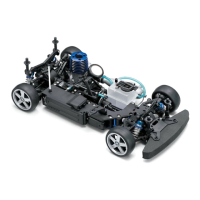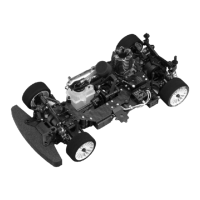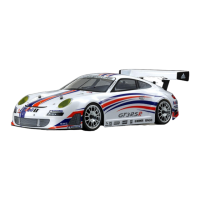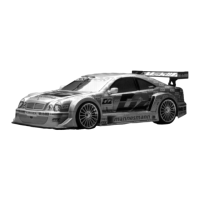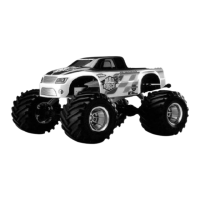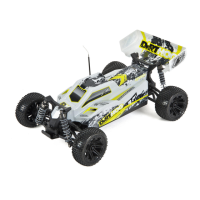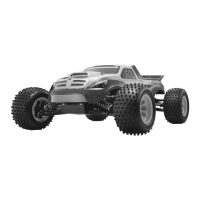Do you have a question about the Kyosho FW-05T and is the answer not in the manual?
Model is not a toy, requires careful assembly and operation by experienced users.
New builders should get advice from experienced modelers for assembly.
Assemble the kit in a location inaccessible to children to prevent accidents.
Keep the instruction manual accessible for future reference after assembly.
Read the entire manual carefully before starting assembly or operation.
Do not connect batteries incorrectly or disassemble them to avoid damage and leakage.
Handle small/sharp parts with care and keep the product away from children.
Avoid operating the model on roads, in crowded areas, or near children to prevent accidents.
Exercise caution when using tools like cutters, nippers, and screwdrivers.
Proper ventilation is crucial when performing painting operations.
Always switch off the model and transmitter and remove batteries when the model is not in use.
Do not operate near models using the same radio frequency to prevent control loss.
Do not point the antenna tip near faces as it can cause injury.
Avoid long-term storage in areas with high temperatures, humidity, or direct sunlight.
Avoid operating the model on roads, near children, in parks, or indoors.
Ensure transmitter batteries are checked and fresh for reliable control.
Immediately stop and diagnose the model if it behaves unusually.
Always handle fuel outdoors, use only glow fuel, and store it safely away from children.
Avoid contact with hot engine parts and rotating components after operation.
List of tools provided with the FW-05T model kit.
Specifies batteries, fuel, and other necessary items not included in the kit.
Important notes on battery compatibility, specifically regarding Oxyride batteries.
Explanation of transmitter functions like power switch, steering, throttle, trims, and indicators.
Guide to using servo reversing switches for steering and throttle operation.
Warning against using transmitters other than the one supplied with the product.
Replace transmitter batteries when the indicator shows low power to maintain control.
Learn how to adjust steering angle sensitivity using the Steering D/R Adjuster.
Diagram identifying the main chassis, front and rear suspension units.
Diagram identifying the engine, gearbox, fuel tank, and servos.
Identifies and explains the basic parts of the engine, like needle valve and carburetor.
Comprehensive checklist to ensure the model is ready for operation and safe.
Diagnosing and resolving problems when the starter cord cannot be pulled or can be pulled.
Addresses issues like low temperature, overheating, clogged carburetor, and incorrect engine adjustment.
Explanation of break-in importance, associated risks, and factory settings for new engines.
Detailed guide on starting, adjusting idle, running, and completing the engine break-in.
Steps for adjusting the needle valve for max RPM and the idle mixture screw.
Essential steps to follow after each run to clean, lubricate, and protect the model.
Ensure engine is adjusted and always perform adjustments with the engine stopped.
Guide on adjusting shift timing using screws for optimal engine usage and performance.
How to hold the transmitter and antenna for optimal control.
Tips on gently using the throttle and steering for better control and practice.
Adjusting steering D/R and practicing figure 8s for improved handling.
Experimenting with full throttle and steering to experience the model's performance limits.
Model is not a toy, requires careful assembly and operation by experienced users.
New builders should get advice from experienced modelers for assembly.
Assemble the kit in a location inaccessible to children to prevent accidents.
Keep the instruction manual accessible for future reference after assembly.
Read the entire manual carefully before starting assembly or operation.
Do not connect batteries incorrectly or disassemble them to avoid damage and leakage.
Handle small/sharp parts with care and keep the product away from children.
Avoid operating the model on roads, in crowded areas, or near children to prevent accidents.
Exercise caution when using tools like cutters, nippers, and screwdrivers.
Proper ventilation is crucial when performing painting operations.
Always switch off the model and transmitter and remove batteries when the model is not in use.
Do not operate near models using the same radio frequency to prevent control loss.
Do not point the antenna tip near faces as it can cause injury.
Avoid long-term storage in areas with high temperatures, humidity, or direct sunlight.
Avoid operating the model on roads, near children, in parks, or indoors.
Ensure transmitter batteries are checked and fresh for reliable control.
Immediately stop and diagnose the model if it behaves unusually.
Always handle fuel outdoors, use only glow fuel, and store it safely away from children.
Avoid contact with hot engine parts and rotating components after operation.
List of tools provided with the FW-05T model kit.
Specifies batteries, fuel, and other necessary items not included in the kit.
Important notes on battery compatibility, specifically regarding Oxyride batteries.
Explanation of transmitter functions like power switch, steering, throttle, trims, and indicators.
Guide to using servo reversing switches for steering and throttle operation.
Warning against using transmitters other than the one supplied with the product.
Replace transmitter batteries when the indicator shows low power to maintain control.
Learn how to adjust steering angle sensitivity using the Steering D/R Adjuster.
Diagram identifying the main chassis, front and rear suspension units.
Diagram identifying the engine, gearbox, fuel tank, and servos.
Identifies and explains the basic parts of the engine, like needle valve and carburetor.
Comprehensive checklist to ensure the model is ready for operation and safe.
Diagnosing and resolving problems when the starter cord cannot be pulled or can be pulled.
Addresses issues like low temperature, overheating, clogged carburetor, and incorrect engine adjustment.
Explanation of break-in importance, associated risks, and factory settings for new engines.
Detailed guide on starting, adjusting idle, running, and completing the engine break-in.
Steps for adjusting the needle valve for max RPM and the idle mixture screw.
Essential steps to follow after each run to clean, lubricate, and protect the model.
Ensure engine is adjusted and always perform adjustments with the engine stopped.
Guide on adjusting shift timing using screws for optimal engine usage and performance.
How to hold the transmitter and antenna for optimal control.
Tips on gently using the throttle and steering for better control and practice.
Adjusting steering D/R and practicing figure 8s for improved handling.
Experimenting with full throttle and steering to experience the model's performance limits.
| Scale | 1/10 |
|---|---|
| Tire Type | Rubber |
| Fuel Tank Capacity | 75cc |
| Engine | GXR-15 |
| Suspension | Double Wishbone |
| Shock Absorbers | Oil Filled |
| Engine Size | 2.5cc |
| Starting System | Pull start |
| Transmission | 2-speed |
